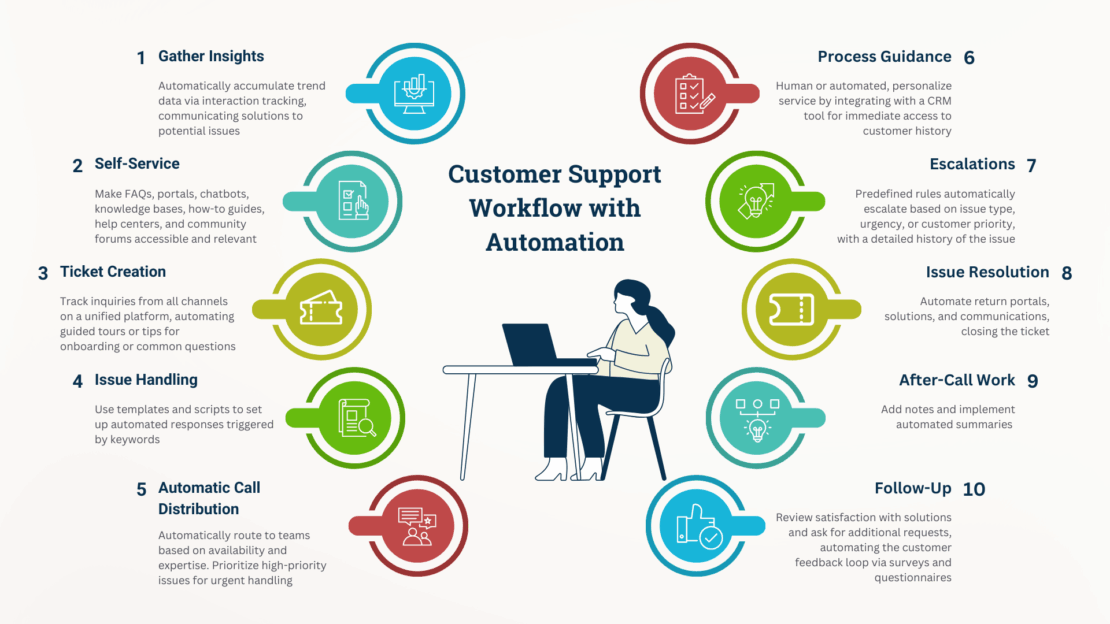Automation empowers scalable, hyper-personalized customer support by reducing handle time, increasing service capacity, enhancing self-service, and tailoring responses to individuals via AI capabilities such as Machine Learning and RPA.
Read Time: 11 minutes
Table of Contents
Introduction
Customers are taking more control over their shopping journey than ever before. Gartner reports that 4 in 10 consumers spend more time verifying the reliability and accuracy of product and service information than they did 5 years ago, demonstrating the need for a customer-centric approach that empowers customers while offering actionable solutions for their pressing needs.
As digital automation transforms customer experience (CX) at an exponential rate, business process outsourcing (BPO) leaders are finding more substantial ways to put the customer first while scaling operations for their partners.
Automation has existed in a variety of forms since BPOs started owning customer care, from software development to custom IVR functionalities and now tailored automated responses in multiple platforms. Grasp the benefits of personalized service of automations by implementing the tips and modern-day expertise of them in this guide.
Key takeaways
- Customer-centric automation is essential: With consumers increasingly scrutinizing information and seeking personalized experiences, BPOs must adopt automation technologies (like AI, RPA, and ML) to enhance customer experience while addressing evolving expectations and pain points.
- Smart automation enables scalability and efficiency: BPO automation streamlines workflows, improves service quality, and helps businesses handle volume spikes, 24/7 support demands, and multichannel interactions—boosting metrics like handling time, CSAT, and agent retention.
- The future lies in AI-human collaboration: Effective BPO strategies combine intelligent automation with emotional intelligence, ensuring ethical AI usage, real-time adaptability, and personalized engagement—delivering both operational excellence and human connection.

What does automation in the BPO industry really mean today?
Automation is the talk of the contact center town, but all the hype can distract from what it actually entails for businesses and customers. Without a clear guide map, companies waste time and resources inefficiently automating irrelevant processes that fail to answer customer needs. Discover how automations put the customers first by understanding the distinct ways customer service BPOs use them to enhance the customer experience.
Start with capturing a full-picture of the scope of automations in call centers.
What is BPO automation?
As experts in customer care, BPOs utilize industry-leading technology solutions that automate responses to simple or routine requests. These automations reduce issue handling time and the reliance on human agents, allowing BPOs to scale for demand surges or large queues. Automations can also accurately predict potential pain points for support teams to act upon for proactive preventative care.
The applications—and trust, as well as proficiency and confidence—in the systems expand as you learn how the technology operates. These technologies play key factors in contact center automations:
- Robotic process automation (RPA): Software robotics uses intelligent automation technologies to perform repetitive office tasks such as extracting data, filling out forms, moving files, and more. API data and UI interaction data inform scripts and rules that emulate human processes and complete transactions across unrelated software systems.
- Machine Learning (ML): A branch of artificial intelligence that enables computers to imitate the way that humans learn, perform tasks autonomously, and improve performance through exposure to more data.
- Artificial intelligence (AI): Technology that empowers computers to simulate human learning, comprehension, problem solving, decision making, creativity, and autonomy.
- Chatbots: A computer program designed to simulate human conversation through text or voice interactions.

Traditional vs. automated BPO workflows
BPO services originally existed solely to reduce customer care costs using standardized processes and fixed contracts, but the constantly evolving modern tech landscape is demanding more flexibility and creativity of BPOs. Reduced costs are just the tip of the iceberg of service quality expectations.
Now, customers seek personalized support and easy, quickly accessible solutions—and AI programs are learning how to step up to the plate using these key strategies, among many:
- Streamlined workflows
- Enhanced self-service
- Task and resource management
- Workforce management
- Real-time performance monitoring
- Automated data and analytics
Each of these solutions requires customizable functionality to scale with businesses and learn from the evolving needs of their customer bases.
READ MORE: How BPO Call Centers Can Help Your Business
Real-world examples of BPO automation in action
Billing and invoice queries
Ryder Systems, a global leader in fleet management and supply chain solutions, was drowning in manual processes prone to costly, time-intensive errors. The company turned to Datamatics to reduce the risk of duplicate payments and late fees and to reimagine an inefficient reconciliation process. Datamatics used its Intelligent Automation solution to combine AI-driven data extraction, business rule engines, and RPA to transform the invoice process, reducing bill processing time, increasing accuracy, and achieving high operational efficiency in a complex process.
Tier-1 tech support via AI
Kirby, a chemical manufacturer, automated repetitive IT helpdesk tasks using RPA, seeing a 30% productivity improvement in 6 months and 97% automation accuracy.
Voice AI and NLP tools in call centers
Humana, a health insurance company, faced more than 1 million calls each month, most of them routine eligibility or benefits checks. The company’s legacy IVR routed callers to human agents, but the costly model inefficiently handled the calls.
The company partnered with IBM to build the Provider Services Conversational Voice Agent using custom language and acoustic models to understand the healthcare terminology and respond with 90-95% sentence-level accuracy. The voice agent doubled the automated response success rate and slashed the per-inquiry cost by 67%.
Want to scale your business?
Global Response has a long track record of success in outsourcing customer service and call center operations. See what our team can do for you!
The link between automation and hyper-personalized CX
At first thought, automations may seem to come at the cost of personalized service. However, evolving technologies show the error of this way of thinking. As technologies better learn human language, they can provide more custom solutions using historical data and real-time sentiment analysis. Find the link between automation and personalized service in these 3 key methods.
1. Scalable issue handling
Ultimately, personalization at scale requires automation. Human teams can only handle so much, and automated processes can seamlessly, accurately, and quickly resolve a large amount of issues while maintaining high-quality levels of service. Automations reduce request queues, increasing your company’s service capacity while improving customer and agent satisfaction.
2. Process guidance
Dynamic workflows guide users through unique journeys, offering real-time tips and process information by pulling key knowledge from constantly updated knowledge bases. This automation reduces the need for live agents to spend excess time assisting customers while gathering data about pain points and effective solutions for your business to act on and improve.
3. Predictive analytics
Real-time interactions constantly teach AI programs to understand customer behavior, including contextual clues and customer intent. This advanced machine learning forecasts customer needs and tailors automated responses with the most effective solutions, boosting efficiency, resource management, and risk adherence.

Case study snapshot
Dynamic Yield offers real-time personalization by creating tailored, cross-channel experiences for customers. It aligns offers with customer preferences and predicts future needs through advanced modeling and precision targeting. Key strategies include notifying users of price reductions for abandoned products, product upselling and cross-selling through deep learning, and targeting promotions to specific audiences in email communications.
Scalability through smart automation
Faster issue resolution is a key basis of efficiency in business because it allows your team to do more in less time—essentially, it increases your service capacity without forcing you to spend time and money building an internal team and the space they need to operate. Instead, outsourced BPO allows your business to scale, solving common issues businesses face in customer support.
Seasonal spikes
Demand surges—expected or not—can overwhelm the best team in an instant. As queues grow, customers grow restless and frustrated, increasing tensions, churn, and dissatisfaction with your business as a whole. Automations allow your team to effortlessly accommodate these volume spikes, empowering customer self-service and satisfaction.
Tip: Reduce the amount of time your team spends answering routine questions and requests with custom automations addressing specific seasonal requests.
24/7 support
Customers expect immediate solutions to their problems, regardless of your business hours. Expand your coverage to offer tailored support when they need it with automated expert support.
Intelligent routing seamlessly directs customers to appropriate teams, efficiently managing the workload even outside of business hours. AI agents expertly handle issues on weekends and holidays, after hours, and as extra support during overflow, offering personalized suggestions based on historical data.
Tip: Implement automated customer feedback requests after each interaction and implement changes based on the data to constantly improve products, services, and support practices.
Unified multichannel support
Automated tools take the mess out of handling interactions via the many communication platforms your customers use. Meet customers where they’re at by capturing all requests in a powerful omnichannel strategy. AI tools track and monitor all communications, accumulating valuable Voice of the Customer data and providing solutions based on each platform for nuanced care.
READ MORE: Healthcare BPO Services: Navigating Success in Healthcare Outsourcing
Metrics that prove it works
It’s easy to talk about how automation can transform business practices in theory, but automations can offer measurable and tangible impacts on your company. Look at the results to determine how much of an asset automated processes can be. Consider these impacts automation can have on key performance metrics:
- Reduced handling time: Faster resolution reduces the amount of time tickets are opened, and automated reports reduce after-call work. Streamlined handling also ensures your human agents are free to spend more time developing relationships and resolving complicated issues.
- Improved NPS/CSAT: Zendesk reports that 81% of consumers believe AI has become essential to modern customer service. Enhanced service, better understanding of customer behaviors, and more effective solutions boost satisfaction and encourage customer retention and recommendations of your services.
- Lower agent burnout and turnover: Automation should support, not replace, your agents. Zendesk also reports that 79% of agents believe AI copilots supercharge their abilities, empowering them to deliver superior service. Automated workflows streamline workflows, reduce queues, and empower continuous improvement with real-time assistance.
Choosing a BPO partner with automation capabilities
Powerful automation is a key feature of a contact center BPO service provider that will get you the results you seek. Define and evaluate these important automation criteria for your ideal potential BPO partner:
- Tech stack integration – Integrations with your existing systems should be seamless and secure.
- AI automation expertise – Your new team should be familiar with your new technology’s AI features and how to use them for peak results.
- CX innovation readiness – An ideal partner should use automations as a jumping point to tailor solutions to customer pain points and your business goals. They should always be looking for new ways to creatively enhance the customer experience with a strategic plan for constant improvement.
Questions to ask a potential BPO partner
Anyone can say they automate effectively, but their ideas of automation may not always align with yours. Determine how your potential partners implement these solutions into their customer care strategy by asking these basic but vital questions.
- What automation tools do you use?
- How do you personalize interactions at scale?
- How do you preserve legacy expertise in your processes?
- Do you have real-time reporting dashboards?
- What automated analytics capabilities do you offer?
- Do you have in-house automation tools or recommend third-party partners?
- What level of customization do your solutions offer for our specific business needs?
READ MORE: Tailoring BPO Services Around Evolving Customer Needs in Niche Markets
Future trends: AI + human collaboration in BPO
The constantly evolving natures of technology and customer care guarantee that processes should always be adapting, just as customers do. While the world is becoming increasingly more digital, strategies should also be more human than ever. Customers seek connection, authenticity, validation, and custom responses, requiring businesses to combine artificial intelligence with emotional intelligence for effective customer engagement.
The rise of AI copilots powers your business and your agents to respond to more customers than ever before. Predictive automation gives you more data-driven insight into customers’ expectations, allowing you to anticipate problems and reduce issues customers may face. As AI systems learn from your data, ethical automation and data governance are also increasingly important, highlighting the need for human validation and identifying accountable leaders to take responsibility for your AI systems.
The security of customer data, payments, and relationships demand collaboration between AI automations and human capabilities for continuous improvement and customer success.
Conclusion
BPO automations streamline operations for businesses of all industries, improving efficiency, productivity, service capacity, and customer and agent satisfaction. More than just a cost-reduction solution but still a powerful one, automation is also a competitive necessity for businesses looking to scale their customer support operations and proactively meet the needs of their audiences.
Consult with a BPO partner that puts customers first with an automation-smart strategy.
FAQs
Automations in BPO customer service reduce costs and improve customer satisfaction. BPO automations improve business processes, streamline workflows, reduce workloads, empower rapid scaling, enhance self-service, and provide actionable insights into customer behavior.
No, BPO automations don’t fully replace human agents. Automations support human agents by handling routine tasks, offering real-time assistance, and efficiently routing complex issues to human agents.
To determine if a BPO provider uses automation effectively, consider cost savings, improved accuracy, enhanced productivity, scalability, predictive analytics, and data annotation best practices.
Yes, automation in BPO is secure and compliant with data regulations. BPO companies are well-versed in security protocols and regulatory compliance.
Automation solutions can reduce customer support costs an average of 50-70% compared to traditional support models.




